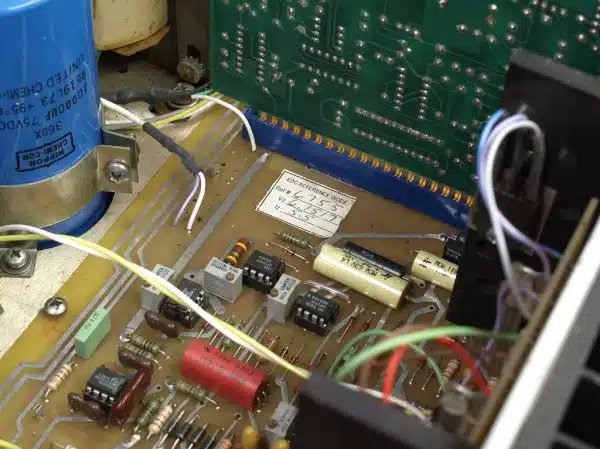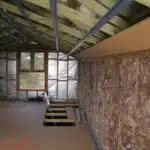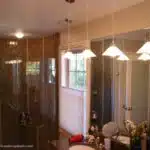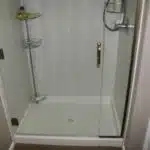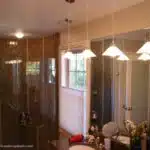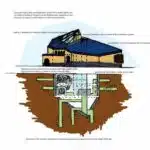As summer temperatures continue to rise, it’s important to find ways to keep your house cool without relying on air conditioning. Not only can excessive AC use be costly, but it also has negative impacts on the environment. Fortunately, there are several effective methods for keeping your home cool that don’t require you to crank up the AC.
One of the most important steps in making your home more energy-efficient is reducing heat gain. This means preventing heat from entering your home in the first place. Simple measures like closing curtains or blinds during the day can block out a significant amount of sunlight and heat. Additionally, sealing gaps around doors and windows with weatherstripping can prevent warm air from infiltrating your home. By implementing these strategies and others, you can achieve a cooler and more comfortable living space while also minimizing your carbon footprint and preserving our planet’s resources.
Understanding Heat Gain And Loss In Your Home
Picture the inside of your home as a greenhouse. Heat from the sun enters through the windows and doors, and gets trapped inside, making your living space feel like a sauna. Understanding heat transfer is key to keeping your house cool without relying on air conditioning units.
Heat gain occurs when heat energy flows into your home from outside sources, such as sunlight or hot air infiltrating through cracks in the walls or around windows and doors. In contrast, heat loss happens when heat energy escapes from the interior of your home to colder outdoor environments. The goal is to minimize heat gain while maximizing heat loss.
Passive cooling techniques are an excellent way to reduce heat gain in your home. These methods involve using natural processes such as convection, radiation, and conduction to move hot air out of your living space and circulate cooler air inside. By implementing passive cooling methods, you can make significant strides towards reducing indoor temperatures without resorting to expensive air conditioning units that consume copious amounts of electricity.
Using natural ventilation to cool your home is one of the most effective passive cooling techniques available. It involves strategically opening windows and doors during specific times of day or night to create cross-ventilation and promote airflow throughout your living space. By understanding how natural ventilation works and applying it correctly, you can keep your house cool all summer long without breaking the bank on high utility bills.
Using Natural Ventilation To Cool Your Home
Natural ventilation is an effective way to cool your home without using air conditioning. This method works by creating a flow of fresh air throughout your home, which helps to reduce the temperature and humidity levels indoors. The pros of natural ventilation include its low cost, energy efficiency, and environmental friendliness. However, there are also some cons to consider, such as noise pollution from outside sources and the potential for allergens and pollutants to enter your home.
To make the most of natural ventilation, it’s important to follow some best practices. Start by keeping windows and doors open during cooler times of the day, such as early morning or late evening. You can also use strategically placed fans to help circulate air throughout your home. Additionally, consider using window coverings like shades or blinds to block out direct sunlight during hotter parts of the day.
If you’re looking for a DIY cooling hack that doesn’t involve air conditioning, there are several options available. One popular method is creating homemade air conditioners using materials like buckets, ice, and fans. Another option is simply placing bowls of ice in front of fans or near open windows to create a cooling breeze. While these methods may not be as effective as air conditioning, they can still provide some relief on hot days while saving money on energy bills.
To further improve your home’s energy efficiency and keep it cool without AC, consider insulating your attic and walls. This step can help prevent heat from entering through the roof or walls during hot weather while also keeping warm air inside during colder months. In the next section, we will discuss how to properly insulate your attic and walls for improved efficiency.
Insulating Your Attic And Walls For Improved Efficiency
While some people believe that air conditioning is the only way to cool a house, the truth is that there are other effective methods. One such technique is insulating your home’s attic and walls. This method has been proven to be both environmentally friendly and cost-effective in keeping your house cool during hot weather.
The benefits of insulation are numerous, including increased energy efficiency and reduced electricity bills. Proper insulation prevents heat from entering or escaping through your home’s attic and walls, which means that you can keep your home cooler without having to rely on air conditioning as much. Additionally, insulation helps keep out unwanted noise pollution by providing an extra layer of soundproofing.
There are several DIY insulation techniques homeowners can use to insulate their attics and walls. One popular method is blown-in insulation, which involves using a machine to blow insulation material into the gaps between wall studs or attic joists. Another option is batt insulation, which consists of pre-cut panels that are installed into wall cavities or laid in attic spaces. Both options are relatively easy to install yourself with some basic tools and equipment.
Insulating your attic and walls can significantly improve your home’s energy efficiency while also reducing noise pollution from outside. By using DIY techniques, you can save money on installation costs and enjoy the benefits of a cooler home without having to rely solely on air conditioning. In the next section, we will explore how installing energy-efficient windows and doors can further enhance the cooling capabilities of your home.
Installing Energy-Efficient Windows And Doors
Energy-efficient windows and doors are a great way to keep your house cool without using an AC. There are numerous window and door styles available that can increase the energy efficiency of your home while keeping it cool in hot weather. The most cost-effective materials for windows and doors include vinyl frames, fiberglass, and wood.
Vinyl frames are the most affordable option when it comes to energy-efficient windows and doors. They offer excellent insulation properties which help to reduce heat transfer into your home. Additionally, they require minimal maintenance and can last for many years. Another cost-effective option is fiberglass frames which are durable, long-lasting, and energy-efficient. They provide excellent insulation properties that help to keep your home cool during hot weather.
Wooden frames are also a good option for energy-efficient windows and doors but may be more expensive than other materials such as vinyl or fiberglass. However, they offer excellent insulation properties which make them ideal for hot climates. Wooden frames can be designed in various styles to complement the aesthetic of your home.
Upgrading your windows and doors with energy-efficient options is a great investment that will pay off in the long term by reducing your energy bills while keeping you comfortable all year round. In the next section, we will discuss how using ceiling fans to improve airflow is another effective way to keep your house cool without AC.
Using Ceiling Fans To Improve Airflow
Ceiling fans are a cost-effective way to improve air circulation in your home. Proper placement of ceiling fans can increase the effectiveness of natural ventilation and decrease the need for air conditioning. When looking for a ceiling fan, it is important to choose the right size for your room in order to maximize its benefits.
Ceiling fan placement is crucial to their effectiveness. Ideally, they should be installed in the center of the room and at least 7 feet above the floor. This allows them to circulate air throughout the entire space and prevents any obstructions from limiting their effectiveness. Additionally, installing fans near windows or doors can help pull cool air into your home while pushing hot air out.
Choosing the right fan size is also important. The size of your room will determine what size fan you need to purchase. A small room (up to 75 square feet) requires a 29-36 inch fan, while larger rooms (up to 350 square feet) require a 52-inch fan or larger. Purchasing a fan that is too small or too large can reduce its effectiveness and lead to wasted energy consumption. By properly placing and sizing your ceiling fans, you can improve airflow in your home without relying on AC.
To further reduce temperatures indoors, creating shade with trees or awnings can be an effective solution. By blocking direct sunlight from entering your home during peak daytime hours, you can reduce heat buildup and decrease reliance on AC units. In addition, planting trees around your house not only provides shade but also helps absorb carbon dioxide from the atmosphere, promoting environmental sustainability. Overall, using ceiling fans in combination with creating shade through natural means can significantly improve indoor comfort levels while reducing energy costs.
Creating Shade With Trees Or Awnings
Ceiling fans are a great way to improve airflow in your home, but what about those hot summer days when even the slightest breeze isn’t enough? Fear not! There are other ways to keep your house cool without turning on the AC. In fact, some methods can be more energy-efficient and cost-effective than air conditioning.
One option is to create shade around your home with trees or awnings. Trees can provide natural shade and cooling through transpiration and evaporation. When selecting trees for shade, it’s important to consider factors such as their size, growth rate, location, and maintenance requirements. A landscaping professional can help you choose the right trees for your specific climate and property. On the other hand, awnings can be a more immediate solution that doesn’t require planting or waiting for trees to grow. They come in various designs and materials so you can choose one that matches your home’s style while providing optimal shading.
Another way to keep your house cool without AC is by using heat-reflective window film. This film reflects sunlight away from your windows, reducing heat gain inside your home. It’s an affordable and easy-to-install option that can also prevent UV damage to furniture and flooring. To maximize its effectiveness, make sure to cover all windows facing south or west where the sun is strongest during the day.
By following these tips on tree selection, awning design, and using heat-reflective window film, you can keep your house cool without relying on AC alone. Not only will you save money on energy bills but also reduce your carbon footprint and contribute to a more sustainable future.
Using Heat-Reflective Window Film
Heat-reflective window film is an efficient way to keep your house cool without AC. This type of film helps in reducing the amount of heat that enters your home by reflecting sunlight and reducing glare. By doing so, it maintains a cooler temperature inside, making you feel comfortable during hot summer days.
One of the benefits of using heat reflective window film is that it reduces energy consumption. As it blocks out the sun’s rays, you don’t need to use your air conditioner as frequently as before, leading to lower energy bills. Furthermore, this type of film also protects your furniture and other home decor from fading due to excessive sunlight exposure.
The installation process of heat reflective window film is quite simple. All you need to do is measure the size of your windows and cut the film accordingly. Then, clean the window surface thoroughly before applying the adhesive side of the film onto the glass. Smooth out any creases or bubbles with a squeegee or credit card and trim off any excess material. With proper installation, you can enjoy all the benefits that come with heat reflective window films for years to come.
To further reduce heat in your home, avoiding heat-generating activities during peak hours can be helpful. By doing so, you can minimize extra warmth being added to your home and maintain a cooler temperature. Let’s explore this topic further in our subsequent section on how to keep your house cool without AC through daily habits and routines.
Avoiding Heat-Generating Activities During The Day
Just like how a marathon runner conserves energy by avoiding unnecessary movements, you can keep your house cool by avoiding heat-generating activities during the day. Daytime activity restrictions are crucial in reducing the amount of heat produced in your home. Activities such as cooking, using the oven, and drying clothes indoors generate a considerable amount of heat that can raise the temperature inside your house.
Instead of preparing hot meals, opt for cooling foods such as salads, sandwiches, and smoothies. These foods will not only help you to stay hydrated but also reduce the need to use kitchen appliances that emit heat. You can also consider grilling outdoors or utilizing your microwave instead of using the oven.
By limiting daytime activities that generate excess heat and consuming cooling foods, you can significantly reduce the amount of heat generated in your home. This approach is essential if you want to keep your house cool without air conditioning. In the next section, we will explore another vital aspect of keeping your house cool – making smart use of your appliances.
Making Smart Use Of Your Appliances
Household appliances can play a significant role in the temperature of your home. By taking advantage of smart thermostat programming, you can reduce unnecessary energy consumption and lower your cooling costs. Smart thermostats allow you to set schedules for when your air conditioning system will operate, thus making sure it runs only when necessary. You can also program the thermostat to turn off your AC before you leave home and turn it on just before you return. This feature ensures that you are not wasting energy while still keeping your home comfortable.
Natural cooling techniques are another effective way to keep your house cool without AC. For instance, keeping windows and doors open during cooler hours of the day allows for natural ventilation that cools down the interior spaces. This method reduces heat build-up inside your home while providing fresh air circulation, which improves indoor air quality and makes the environment more comfortable to live in. Additionally, using window coverings such as curtains or blinds helps block out direct sunlight and keeps heat from entering the house.
To further maximize energy conservation, homeowners may consider upgrading their older appliances with newer models which are designed to be more efficient. It is essential to note that appliances such as refrigerators, dishwashers, washing machines, and dryers generate heat when running. Therefore, it is best to avoid running these appliances during peak daylight hours or at night when they can contribute to warming up a room.
By making smart use of household appliances and incorporating natural cooling techniques into your daily routine, you can keep your home comfortable without relying on AC alone. In the next section, we will explore how using cooling fabrics for bedding and furniture can add an extra layer of comfort to your living space.
Using Cooling Fabrics For Bedding And Furniture
Making smart use of appliances can significantly reduce the temperature in your home without relying on AC. However, another effective way to keep your house cool is by choosing breathable fabrics for bedding and furniture. These materials allow air to circulate freely, resulting in a fresher and cooler environment.
When selecting fabrics for your home, look for those that are lightweight and made from natural fibers such as cotton or linen. These materials are breathable and offer excellent ventilation while also being soft and comfortable to the touch. Avoid synthetic fabrics like polyester or nylon as they trap heat and prevent air from flowing through.
Another way to incorporate cooling textiles into your home is by using them for curtains. Fabrics such as sheer or voile curtains not only add elegance to your decor but also provide a functional purpose by allowing air to pass through them. In addition, using light-colored curtains can help reflect sunlight, reducing the amount of heat entering your home.
| Material | Breathability | Comfort |
|---|---|---|
| Cotton | High | High |
| Linen | High | High |
| Polyester | Low | Low |
By incorporating breathable fabrics into your home design, you can effectively reduce the temperature without relying solely on AC. Choosing natural fibers like cotton and linen will keep you cool while providing comfort. Additionally, using cooling textiles for curtains will allow air to flow more freely while adding a stylish touch to your living space. With these tips in mind, you can create a relaxing environment that beats the summer heat while saving energy at the same time. Next up, we’ll explore how properly maintaining your HVAC system can further improve energy efficiency in your home.
Properly Maintaining Your Hvac System
Maintaining your HVAC system is essential if you want to keep your home cool and comfortable during the hot summer months. One of the most critical aspects of maintenance is replacing your HVAC filter regularly. A dirty or clogged filter can restrict airflow, causing your system to work harder than it needs to, resulting in higher energy bills and reduced cooling efficiency. Experts recommend replacing filters every one to three months, depending on usage.
Another essential aspect of maintaining your HVAC system is having your ductwork inspected regularly. Leaks or gaps in your ducts can result in conditioned air escaping, leading to decreased cooling efficiency and increased energy bills. An inspection by a professional technician can identify any issues with your ducts so that they can be promptly addressed before they become more severe.
To create a vivid image in your mind, consider the following bullet point list:
- Imagine air flowing through your home like water through pipes.
- If there are leaks or gaps in those pipes, water will escape and go to waste.
- Similarly, when conditioned air escapes from leaky ductwork, it’s like throwing money out the window.
By properly maintaining your HVAC system by replacing filters and inspecting ductwork regularly, you can ensure that your home remains cool and comfortable throughout the year while also reducing energy waste and saving money on utility bills.
Transition: Now that we’ve covered how to maintain your HVAC system for optimal cooling efficiency let’s move on to making your home more energy-efficient overall.
Making Your Home More Energy-Efficient Overall
Proper maintenance of your HVAC system can keep your home cool during hot summer months, but it’s not the only way to keep your home comfortable. Did you know that green landscaping around your home can significantly reduce indoor temperatures? According to research, shading from trees and shrubs can lower the temperature of nearby surfaces by 20-45°F, which translates into a cooler home.
Another cost-effective solution for keeping your home cool is air sealing. A lot of energy is wasted because of air leaks in homes, causing indoor temperatures to fluctuate and making it harder for HVAC systems to maintain a consistent temperature. DIY air sealing techniques, such as caulking and weather-stripping, can be easily done by homeowners and improve energy efficiency by up to 30%.
In addition to these solutions, utilizing cool roofing materials is another way to keep your home cool without AC. These roofs are designed to reflect more sunlight and absorb less heat than traditional roofs. Cool roofs come in a variety of options such as shingles or tiles made with reflective materials or coatings that increase solar reflectance. By choosing the right roofing material, you can reduce up to 15% of your cooling costs while also reducing the urban heat island effect in your community.
Utilizing Cool Roofing Materials
Cool roofing materials can be an effective way to keep your house cool without using AC. These materials reflect more sunlight and absorb less heat than traditional roofing materials, which can help reduce the amount of heat that enters your home. The benefits of cool roofing materials are many, including lower energy bills, reduced environmental impact, and improved indoor comfort.
The installation process for cool roofs varies depending on the type of material being used. Some common options include reflective coatings, shingles or tiles that are designed to reflect sunlight, or metal roofs that have a highly reflective surface. Regardless of the material chosen, it is important to work with an experienced contractor who understands the unique challenges and requirements associated with installing a cool roof.
Overall, utilizing cool roofing materials is a great way to keep your house cool without relying on AC. By reflecting more sunlight and absorbing less heat, these materials can help reduce indoor temperatures and improve overall comfort. If you’re interested in exploring this option further, be sure to work with a qualified contractor who can guide you through the installation process and help you choose the right material for your needs. In the next section, we’ll explore another effective strategy for keeping your home cool: installing a whole-house fan.
Installing A Whole-House Fan
After discussing the benefits of cool roofing materials, one might think that their house is already well-equipped to combat the heat. Unfortunately, this is not always the case. While cool roofs can reflect sunlight and reduce heat absorption, they do not directly impact indoor temperatures. This is where a whole-house fan comes in.
A whole-house fan is a ventilation system that draws hot air out of your home and replaces it with cooler air from outside. Unlike air conditioning units, it does not use refrigerants or require ductwork installation, making it an eco-friendly and cost-effective alternative. However, there are also potential drawbacks to consider before deciding on this option.
One major drawback is its installation process. While it can be installed by a DIY enthusiast, it does require electrical work and cutting holes in your ceiling for proper ventilation. It may also not be suitable for every climate or household structure since it relies on outdoor temperatures being cooler than indoor temperatures at night. Despite these challenges, a whole-house fan can provide significant energy savings and improved indoor air quality compared to traditional cooling systems.
Considering Alternative Cooling Options Like Evaporative Cooling Or Geothermal Systems
Alternative cooling options such as evaporative cooling and geothermal systems can be effective in keeping your home cool without relying on air conditioning. Evaporative cooling, also known as swamp coolers, work by blowing hot air through water-soaked pads. As the hot air passes through the wet pads, it cools down and is circulated throughout your home. This type of system is most effective in dry climates, where humidity levels are low.
On the other hand, geothermal systems rely on the earth’s natural heat exchange process to keep your home cool. This system uses pipes buried underground to circulate a mixture of water and antifreeze. The liquid absorbs heat from your home, which is then released into the ground. Geothermal systems are highly efficient and can save you up to 70% on your cooling costs.
When considering alternative cooling options for your home, it’s important to compare the cost of each system. While evaporative coolers are generally less expensive than geothermal systems, they may not be as effective in humid climates. Additionally, geothermal systems require a higher upfront investment but provide long-term savings on energy bills.
By considering alternative cooling options like evaporative cooling or geothermal systems, you can keep your home cool without relying on traditional air conditioning units. Whether you live in a dry or humid climate, there is an option that will fit both your budget and lifestyle needs. It’s important to do research and consult with a professional before making any decisions about which system is right for your home.
Conclusion
Understanding the principles of heat gain and loss is essential to keeping your home cool without relying on air conditioning. By utilizing natural ventilation, insulating your attic and walls, installing energy-efficient windows and doors, using ceiling fans, making your home more energy-efficient overall, and considering alternative cooling options like evaporative cooling or geothermal systems, you can significantly reduce your reliance on AC.
However, it’s important to note that these measures are not just about keeping cool; they are also about reducing your carbon footprint and saving money on energy bills. By implementing these strategies, you can create a more sustainable home that benefits both the environment and your wallet. So don’t hesitate to make some changes today – whether it’s adding insulation or investing in a whole-house fan – because every little bit helps when it comes to creating an energy-efficient home.
Image Credits
- “Krohn Hite EDC 4601 AC Voltage Standard” by eevblog (featured)

